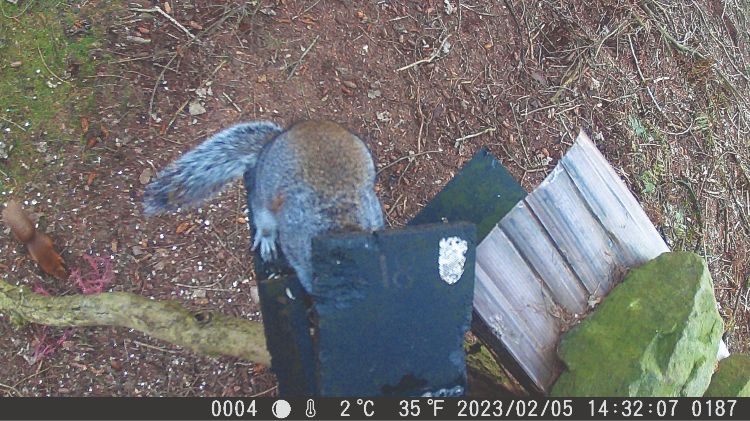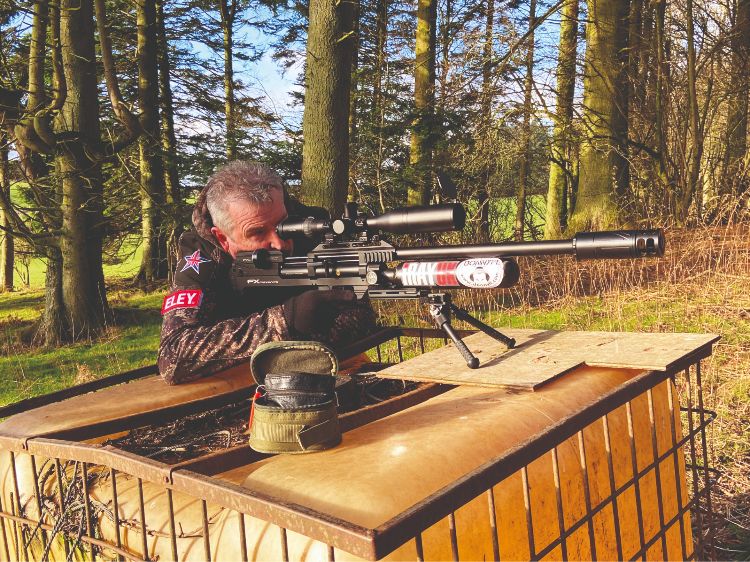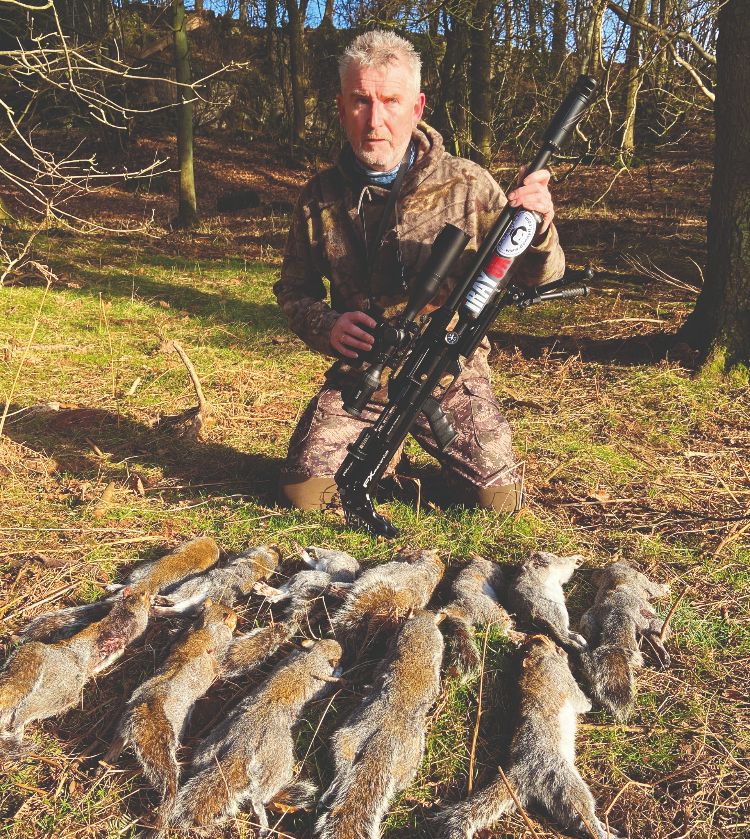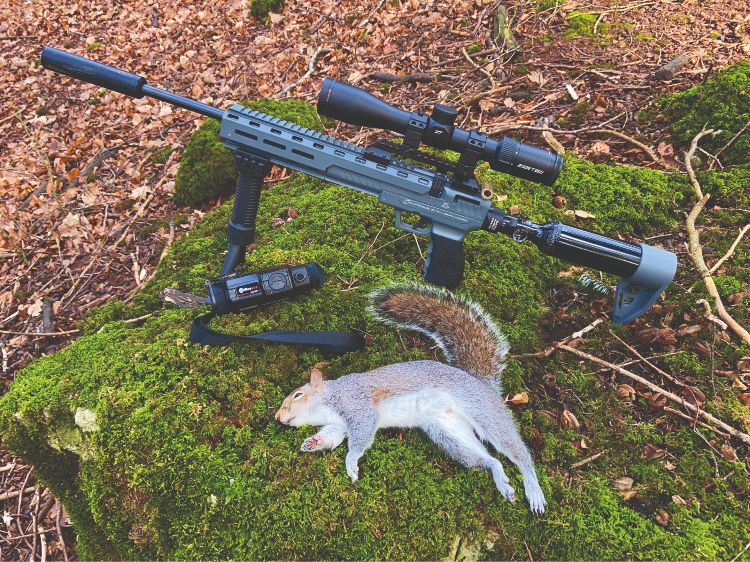For many shotgunners, the pheasant season comes around too slowly, and then in a blink of an eye, it’s all over until October. For me, it’s a different story; I spend eight months chasing, stalking, trapping and shooting grey squirrels, and between all this, I’ll be supplementary feeding the red squirrels and monitoring numbers and movements. All this makes for long days, but the rewards of seeing the red squirrels either flourishing in an established red area, or to see reds arrive in new areas, is what all the pest controllers up and down the country want to see.
On a handful of estates I cover, though, it comes with caveats in the shape of restricted access during the ‘shoot season’ – not all are totally restrictive, but I have to adhere to their requirements because so much time, effort and money goes into the organisation of the shoots and expectations can be high from the ‘guns’ who pay for their days out.
Two of the shoots allow me on, up to a couple of days prior to any given shoot, to give the birds time to settle down after my visit, which although not ideal, gives me the time to get in there and provide some intensive grey control. Another shoot is much more understanding, and as long as I swerve the particular shoot day, then I’m good to go. This is probably due to them listening to me highlighting the number of greys in this actual woodland, and the fact that in previous years, the greys have been running riot on the pheasant feed hoppers, either emptying them or chewing their way into the hopper, leaving it open to the elements – and up here in the Lake District, that means rain!
 Inreased sightings of red squirrels
Inreased sightings of red squirrels
The number of greys taken from this particular woodland has been very high, and when I spoke to the farmer and shoot captain, they both had compliments for the conservation work being carried out. It was also noticeable that the amount of feed brought in was less than previous years, even though the bird numbers were the same, and reds have been sighted in numbers not seen before, so some good news there, and I have been asked to check out another couple of areas where they have a shoot – even better news!
The couple of permissions that require two days prior to their shoot have also provided me with the opportunity to keep up with the greys, enough to hold back the incoming tide of. These shoots ended two weeks before the end of the season and I was straight in there, clearing good numbers in a short time. Again, this was an intensive attack because I knew that the estate where there was no access at all would be giving me the call and the all clear, so I could provide some full-on grey control.
The call came from the keeper and we had a lengthy chat about what had been seen and how the season had gone for him. Apparently, he’d only seen one grey and duly dispatched it with the 12 gauge – obviously, I had to take the mick a little. “Ah, so you just sent a barrel full of lead shot somewhere out there, rather than some precise single-shot shooting, and sent everything else in the vicinity to the treetops in the process!’ He takes it well, though, and gives as good as he gets.
 First things first...
First things first...
So, my first day in saw me topping up and cleaning feeders, swapping out SD cards from the trail cams – which would have thousands of images to scroll though – fitting a couple of new trail cams and checking the zero on the FX Maverick.
The live traps were set along with the Remoti activation alert system, which sends me an email when the any monitored trap is activated. These are a real asset and work in a two-fold way, for me. They operate 24/7, but have to be checked periodically, ideally no more than eight hour intervals, but I check more often just in case of malfunctions – I haven’t had any yet.
My preferred method of use for the live trap/Remoti is to set them adjacent, or near to a feeder. The back end has a trip plate that the squirrel has to pass over to get to the feed on offer, and activates the front trap door. A little peanut butter holds the feed in place and acts as an attractant.
On many occasions, I’ve been alerted to an activated trap by the Remoti to find not only a grey in the trap, but another on the feeder, too, and this is the second part of the two-fold work that they do. If I hadn’t had the notification, I might not have had the chance to get on the second grey. I had seen a few greys and reds on my way round that day, but nothing was within range, and I was happy that they would find the feed on offer and the following day would see a few in the bag.
 An early start
An early start
As always, with the excitement of getting on either new land, or back on land not covered for a while, I had a sleepless night and before sunrise I was in the truck and heading to the estate. Whilst en route, I had two pings on the phone; two traps had been activated, and one in particular was a known provider for trapping greys. Last year, this trap/Remoti combination had four greys on four consecutive days, so it wasn’t any surprise to see this one ping up on the phone.
As I headed up a mile-long track lined with rhododendrons, it was immediately obvious, due to the lack of foliage, that my movements would need to be kept slow and steady, using the rhodis to mask my advance where possible.
The first trap that had been activated contained a plump female which was dutifully dispatched using the ‘sack & smack’ method, which entails having an old feed sack over the trap door, opening the door and enticing the skinny out and into the sack, followed by a swift dispatch.
The march forward continued. It’s a constant uphill slog and can really get the lungs going, especially with a full bag of feed, tools and a gun on your back. Today was an easier tab because I only had the gun, which for today was FAC .30 cal – the FX Maverick, with Wildman Slugs. Scope was the excellent Hawke Optics Airmax 4-16 x 50 FFP AMX, and the Fat Boy silencer was supplied by my good friend Donny FL. The Fat Boy does a great job of silencing the bark from the 100 ft.lbs. Maverick, and I chose to use the Mav’ today because I was expecting a few long shots through the woods – getting close would be hindered by the lack of leaf cover.
 Shooting time!
Shooting time!
The next feeder, although not too clear with the naked eye, was showing a heat source sitting on top through the InfiRay FH35R Finder. I could get to within 80 yards or so without alerting the skinny, and getting into the prone position had me scoping two skinnies, one on top and one below, mopping up the discarded feed. A choice of which one to take first was simple; if I took the one up top, then it falling to terra firma would send the lower one off into the rhodis. The ‘schwack’ of the 53gr slugs striking the skull was indeed louder than the muzzle report, but the higher skinny stayed put, and in the time it takes to cycle the mag’, it joined its mate below. I had three in under 20 mins, and I was only 100 yards or so into the wood.
One of the feeders was surrounded by sparsely covered Scots pines, and as I approached they lit up with four heat sources. The superb Finder couldn’t identify whether they were greys or reds at this range, but the Airmax could, and did. Taking aim at the furthest and working my way back, I dropped three of them into the depths of the rhododendrons whilst the fourth made a quick exit. Once more the Finder did the finding and all three were retrieved. Things were looking good and I hadn’t yet got to the known hotspot!
The hotspot is what I call ‘Bob Hole Oak’ because it has a couple of bob holes that the greys use, and from 80-90 yards out I could see a heat source moving around – it was in the trap, but there was a second one on the feeder. This has been a normal occurrence since I first set foot in here. The problem was, there was no clear shot, so I had to make a stealthy and steady weave through the rhodis and other small trees. There are many moss-covered boulders that make a perfect platform to shoot from, and the only weak link was the crappy knock-off bipod that I still haven’t replaced, but rest assured that by the time you read this, I will have replaced it with something more appropriate from the BSS23.
Once in position I had a clear view of the baited area; one grey was in the trap, ratching around looking for an escape route and another sat on the feeder, totally unfazed by the trapped grey, but there was more – a couple on the ground clearing up the spilled feed.
I was sure I could get two of them, plus the one in the trap, with the same method as before, and that’s exactly what happened, although the other ground-feeding skinny didn’t go far and made the mistake of sitting in a nearby beech tree chattering away and flaying its tail wildly. This was taken out with a heart/lung shot; the .30 cal doesn’t take any prisoners with these shots, and the results are a little too graphic for the pages of this publication.
I had one more trap to check out, and this one didn’t have a Remoti, but as I approached, I could see that the door was closed and hear the unmistakable sound of a captive grey seeking release. Another ‘sack & smack’ manoeuvre and that was 11 – more than I’d taken before on my first day back in, but it wasn’t the end just yet.
As I headed back down the track, scanning all the way, I picked up another heat source where I had taken three from the treetops – it had to be the escapee. I moulded myself into a nearby pine tree and located the grey with the Hawke Airmax. I took a couple of breaths to compose myself, then let rip with the 53gr Wildman and watched the grey fold and fall as if in slow motion. The bag stood at 12 for the day and it currently stands at over 20 with, I believe, still more to come.
 The Nemesis X
The Nemesis X
I have recently taken delivery of the long-awaited Nemesis X from Webley and Scott. It’s a PCP airgun based on the CO2 Nemesis and it has intrigued me since I heard of its release some time back. The action is made from ballistic polymer as used by Glock and Weihrauch, and so far, I am very impressed. It is an extremely lightweight airgun – and I mean ‘light weight’! It is also priced at the beginner end of the market – RRP is around the £370 mark, but I have seen it under £330.
It comes with a tandem mag’; single-shot tray and the standard 12-shot mag’; a foregrip that incorporates a built-in bipod; Picatinny rails all round; threaded for a mod; a screw-in rear air bottle; .177 and .22 calibres; a nifty little storage spot in the pistol grip … and to top all this, it’s had its first kill with a skinny. I have ratting and feral plans for this impressive little gun, so watch out for future updates, but please don’t take my word for it – give it look when you get chance.